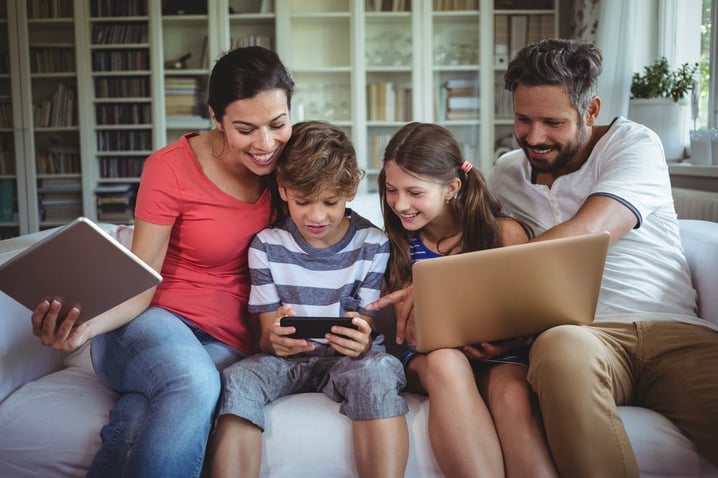
Children are surrounded by screens. They carry them in their pockets, wear them around their wrists, and many have had to rely on them exclusively for schoolwork during distance learning.
While all these digital devices can be excellent tools that make kids more productive, the amount of time spent on them, referred to as screen time, has ignited a lively debate among researchers, educators, and parents over the years.
The American Academy of Pediatrics's (AAP’s) position on children’s screen time use is clear: “children eighteen months and younger shouldn't use screens; children between eighteen and twenty-four months should use screens with parents to watch ‘high-quality programming;’ children between two and five should be limited to two hours per day; and children six and older should be given rules that are deployed consistently.” However, the AAP's recommendations are not as clear on the types of content kids should be engaging with on their screens.
Going off of AAP's parameters, we wanted to see how attitudes towards screens have evolved during the pandemic. Our goal was to compare our parent audience's perceptions to recommended limits.
Hey parents: what is an acceptable amount of daily screen time for kids ages 2-12?
— ST Math (@STMath) April 19, 2021
Nearly half of all respondents were on par with AAP’s recommended limits. However, 23.5% of parents said that they don't place limits on screens at all. Given the range of answers, our poll suggests that the screen time debate is just as nuanced as previously thought.
For many parents, the goal when it comes to screen time and kids is to strike a healthy balance between enrichment and recreation. The use of distance learning programs and other educational content can already take several hours of daily screen time. If you need help guiding your students’ families screen time usage, these simple habits can help to create healthier screen time practices for everyone.
A great way to navigate talking to kids about their screen time usage is to encourage families to develop a media plan together. They’ll start by writing a list of what everyone is doing on their computers, smartphones, or other screens. Is the ratio between educational content and recreational screen time off balance? Families can break down each activity to determine where the excess is and what can be done as an alternative. Some educational games and activities even offer free resources to track progress - like our ST Math data trackers and journal pages. These can help account for productive screen time use during the week.
Families can also set some ground rules to hold everyone accountable. For example, they could make it mandatory for their family to turn off smartphones at the dinner table, or make sure that their kids refrain from mindlessly scrolling through social media when they have a lull in their day.

Children benefit tremendously from family involvement in their learning, especially when playing educational games like ST Math. Assigning ST Math games for homework or summer work can encourage screen time that is focused on learning and fun. In ST Math, the puzzles start simple and then get more challenging as the student progresses. When they reach a challenging problem, they may ask a family member for assistance. You can download and share this list of facilitating questions to help everyone get the most out of these conversations.
Planning dedicated times to view content with kids provides more control over what they are watching and for how long. Encourage families to turn this time into an opportunity to expand their thinking by engaging in conversations around the on-screen content.
Strategic breaks from screens pay dividends in productivity and will keep everyone from burning out. Just like working professionals might take a quick coffee break to reset after a long meeting, kids need to step away, too, especially when learning remotely. Of course, they need to stay focused on the task at hand, but studies show that at least five minutes in every hour of screen time should be spent away from the screen. Families should use this time to encourage kids to stretch, refocus their eyes, or hydrate.
Screens are the enemy of a good night's sleep. Research shows that the stimulating effects of blue light emitted from screens delay melatonin production, a hormone essential to helping us fall asleep. That's why it is critical to build in enough time for kids to unplug after a long day in front of screens. The National Sleep Foundation recommends stopping all use of electronic devices, like phones and tablets, at least 30 minutes before bedtime. If the temptation persists to check up on notifications, make an effort to either power off devices or put them in another room.
A significant problem with screens is that people are physically inactive when using them. A sedentary lifestyle can cause severe metabolic changes that increase the risk of developing chronic health problems.
Encourage families to take a walk or get active with their kids on lunch breaks or at the end of the school day. Increasing outdoor physical activity will help burn off excess energy and reset everyone's mind for the next day. If you need some inspiration, check out these +16 Summer Math Activities for Kids.
Encouraging families to help their kids develop a healthy relationship with electronic media and screens will only help them to become well-rounded individuals. As technology becomes more pervasive in academic and work environments, finding that balance between the real world and the digital world will be more imperative. Families should talk to their kids about the benefits and downsides of screen time, and how to distinguish enriching and educational content from the rest. It will teach kids the importance of using these tools responsibly and having interests that go beyond the screen.

Parker Erickson was MIND’s Content and Community Specialist. As a digital storyteller, Parker is passionate about building strong communities through technology and social media. Off the clock, you can find him buried in the latest issue of The New Yorker or experiencing different cultures through food.
Comment